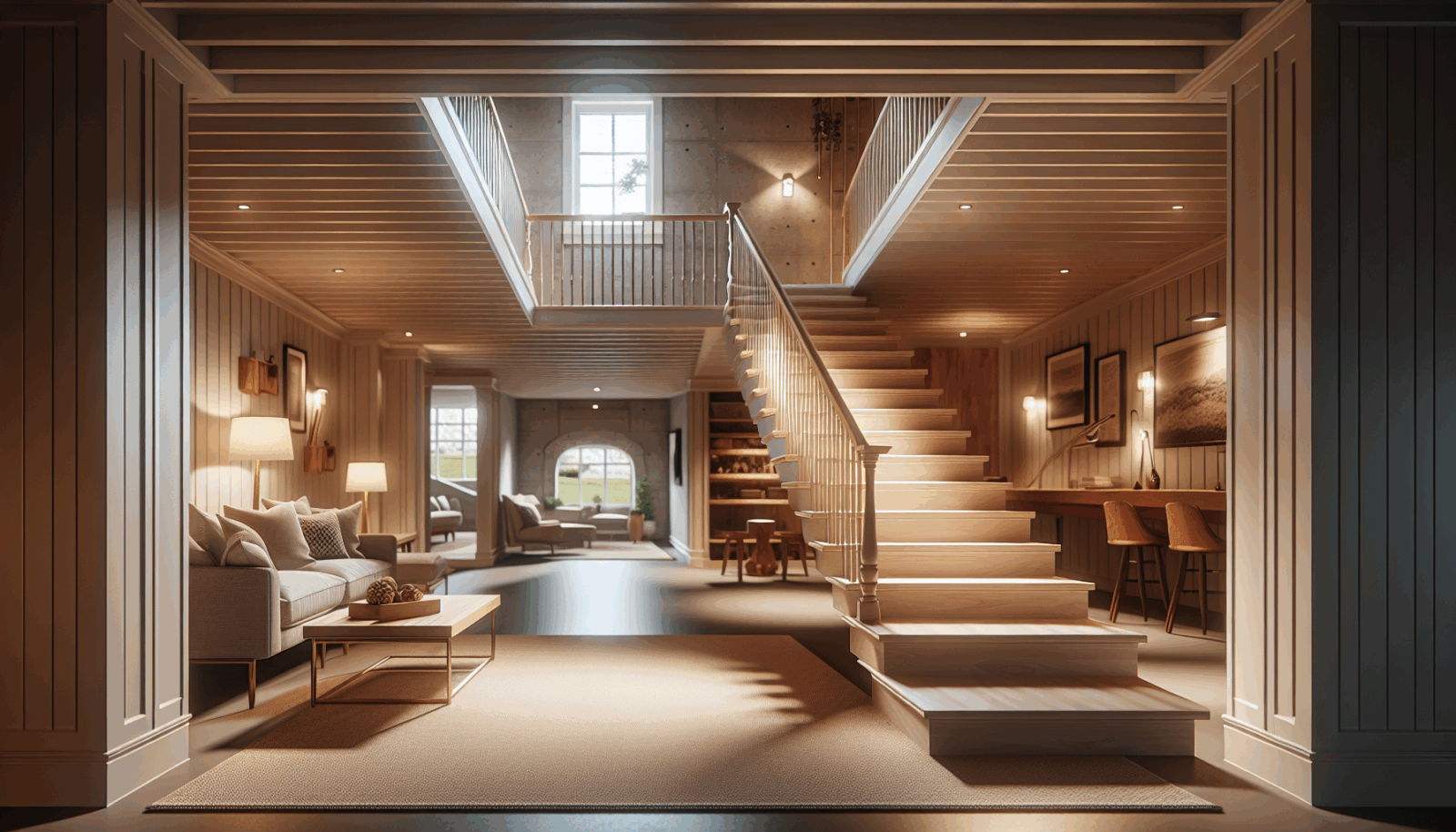Transforming your basement into a vibrant, functional space begins with one critical component: the Stairs. Yet, navigating the myriad of design options can feel overwhelming. That’s where we, at Utah Basement Finishing, come in – wielding years of expertise in revitalizing basements across various counties, we’re here to guide you towards creating not just stairs, but a stunning introduction to your newly purposed space. Whether you’re a seasoned homeowner or embarking on your first renovation project, this guide is tailored to enlighten and inspire your journey.
Contents
- 1 Understanding Your Space: The Foundation of Great Basement Stairs
- 2 The Material Matters: Choosing the Right One for Your Stairs
- 3 Lighting Your Way to Safety and Ambiance
- 4 Incorporating Storage Solutions
- 5 Choosing the Perfect Color Palette
- 6 The Style Direction: Blending with Your Home’s Aesthetic
- 7 Ensuring Safety and Compliance
- 8 Maximizing Natural Light and Ventilation
- 9 Personal Touches: Making the Stairs Uniquely Yours
Understanding Your Space: The Foundation of Great Basement Stairs
Before diving into colors, materials, or styles, assessing the spatial dynamics is paramount. Consider the area available at both the top and bottom of the staircase. Is the space constricted, or do you have room to experiment with wider or curvier designs? Additionally, the height between your basement and the ground floor significantly influences whether you tilt towards straight, L-shaped, or spiral stairs. Getting these dimensions right sets a solid foundation for safety, comfort, and aesthetic appeal.
Equally important is to forecast the utility of your basement. Will it morph into a bustling family room, a serene home office, or perhaps a cozy guest bedroom? The intended use drastically shapes the design elements of your stairs, prioritizing functionality without sacrificing style. After all, the stairway is not just a transition area; it’s a critical component that defines the flow and feel of your basement.
The Material Matters: Choosing the Right One for Your Stairs
When it comes to materials, your choice dictates both the longevity and the vibe of your stairs. Wood, with its timeless elegance, can introduce warmth and classic charm to your basement. Conversely, metal staircases, with their sleek and modern aesthetics, can add a dash of contemporary flair. And let’s not overlook the durability and Cost-effectiveness of engineered wood and laminate options, perfect for those seeking a balance between form and function.
However, the material selection doesn’t stop at the steps; handrails and balusters offer an additional layer to the design narrative. Glass balustrades can amplify the sense of space and light, while wrought iron detailing can infuse a dose of character and intricacy. Consider the broader theme of your basement renovation to ensure cohesion from top to bottom.
Lighting Your Way to Safety and Ambiance
Lighting plays a dual role in basement stairs design: ensuring safety and enhancing the overall ambiance. Strategically placed lights can prevent missteps and falls, making the stairway safe to navigate at any time of the day or night. Recessed lights or LED strips subtly embedded along the sides or beneath the treads provide clear visibility without overpowering the space.
But let’s not overlook the mood lighting can create. Soft, warm tones can make the descent into the basement inviting, encouraging a seamless transition between levels. Consider using dimmer switches to adjust the ambiance according to the occasion or time of day, adding a touch of versatility to your basement stairs.
Incorporating Storage Solutions
Maximizing every inch of your home, including the often-overlooked stairway area, can enhance both functionality and organization. Whether it’s creating deep drawers within the staircase for shoes and seasonal items or installing discreet cupboards under the lower steps for extra linens and towels, integrating storage solutions is a smart design move. Not only does it help declutter other areas of your home, but it also makes the stairway a multifunctional space.
Beyond practicality, these storage solutions can be designed to blend seamlessly with the overall aesthetic of your stairs, maintaining a cohesive and uncluttered look. This approach ensures that your basement stairs contribute to the home’s organization without compromising on style.
Choosing the Perfect Color Palette
The color of your basement stairs can significantly influence the visual flow and atmosphere of your home. Lighter hues expand the sense of space, making tight stairwells appear more open and airy. Contrarily, darker shades can imbue a sense of drama and intimacy, perfect for creating a bold statement.
It’s also worth considering the transition between the upper and lower floors. A harmonious color palette can gracefully guide the transition, while a more distinct choice may delineate the basement as a separate zone with its unique character. Remember, the staircase is an extension of your home’s personality; let it reflect your style and preferences.
The Style Direction: Blending with Your Home’s Aesthetic
The design of your basement stairs should echo the overall architectural style of your home. A mismatched staircase can disrupt the visual harmony, making it stand out for all the wrong reasons. For example, a sleek, contemporary home benefits from the clean lines of a modern stair design, whereas a house with rustic charm might call for wood stairs with natural textures and finishes.
This continuity doesn’t mean a lack of creativity; rather, it’s about finding innovative ways to express your unique style within the architectural context. From the choice of materials to the design and color, every element of your stairs should enhance the cohesive beauty of your home, creating a seamless flow that ties the spaces together.
Ensuring Safety and Compliance
Safety should never take a backseat in the design of your basement stairs. Adherence to building codes and regulations ensures that your staircase is not only aesthetically pleasing but also safe and functional. This includes specifications for stair width, riser heights, tread depths, and handrail dimensions. Engaging professionals, like us at Utah Basement Finishing, guarantees that these considerations are meticulously integrated into your design.
Besides compliance, there are practical safety measures to include, such as non-slip surfaces, adequate lighting, and sturdy handrails. These features are especially important if children, elderly family members, or individuals with mobility issues use the stairs. A well-designed staircase balances safety and style, creating a secure and inviting path to your basement.
Maximizing Natural Light and Ventilation
Basement stairs often act as a conduit for natural light and fresh air, especially in designs that incorporate external entrances or are positioned near Windows. Maximizing these features can transform the ambiance of both the stairway and the basement itself. Consider using materials and colors that reflect light to enhance brightness and the sense of openness.
Ventilation is equally important, ensuring that the air in your basement remains fresh and pleasant. Strategic positioning of vents or the inclusion of an opening window in the stairwell area can significantly improve air circulation. These elements work together to make the descent into your basement a breath of fresh air, literally.
Personal Touches: Making the Stairs Uniquely Yours
- Artistic Elements: Incorporate art pieces or family photos along the stairway walls to add a personal touch and visual interest.
- Decorative Stair Risers: Adding patterns, tiles, or vibrant paint to the stair risers can inject personality and color into the space.
- Unique Handrails: Opting for handrails in unconventional materials or designs can make your staircase stand out as a focal point.
- Accent Lighting: Use creative lighting solutions, such as pendant lights or wall sconces, to highlight architectural features and create ambiance.
- Textural Contrast: Mixing materials and textures, like smooth wood with rough stone, can add depth and interest to your stairway design.
In conclusion, designing your basement stairs should be an exciting journey that enhances the functionality, safety, and aesthetics of your home. With these tips and the help of our expert team at Utah Basement Finishing, your basement can evolve into a continuously flowing extension of your living space. Ready to take the next step? Connect with us by phone at 801-515-3473 or Request a Free Quote.




